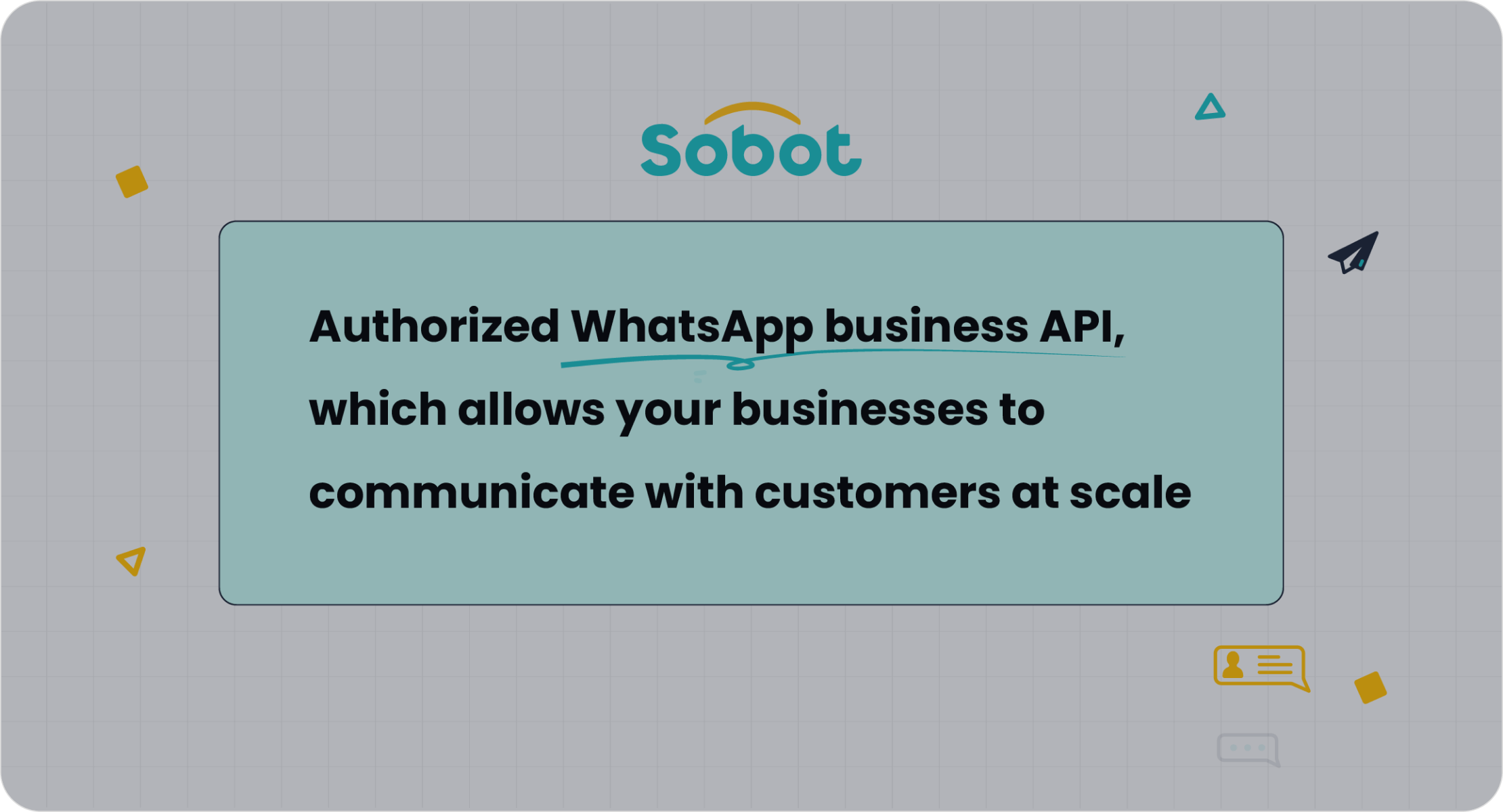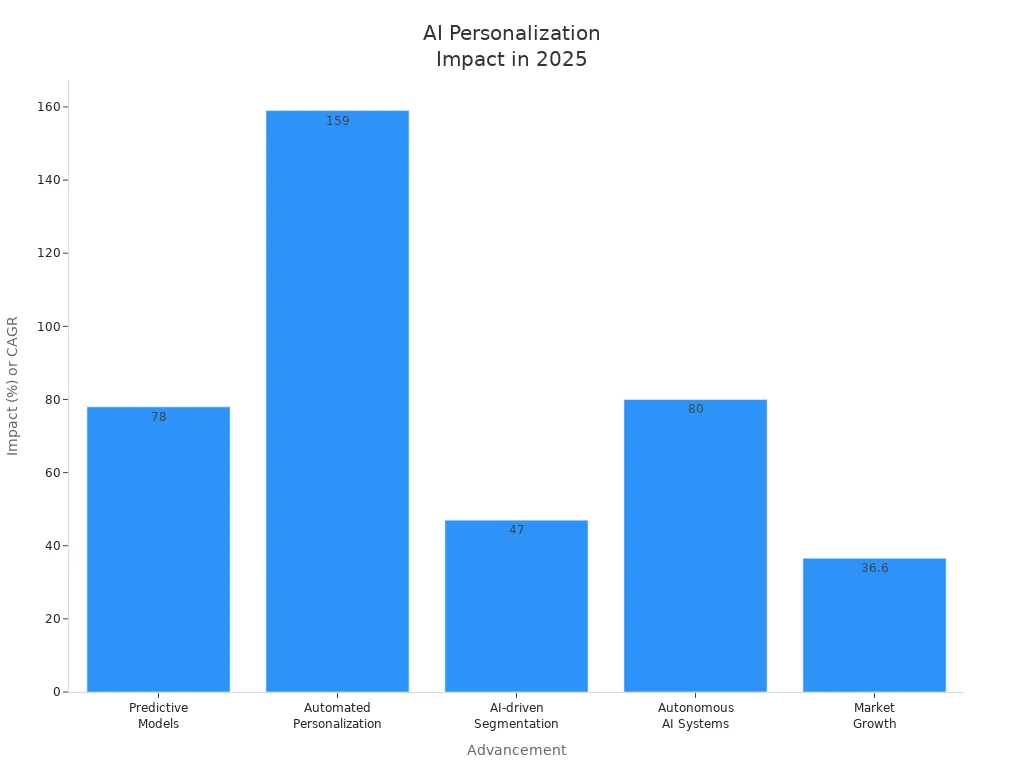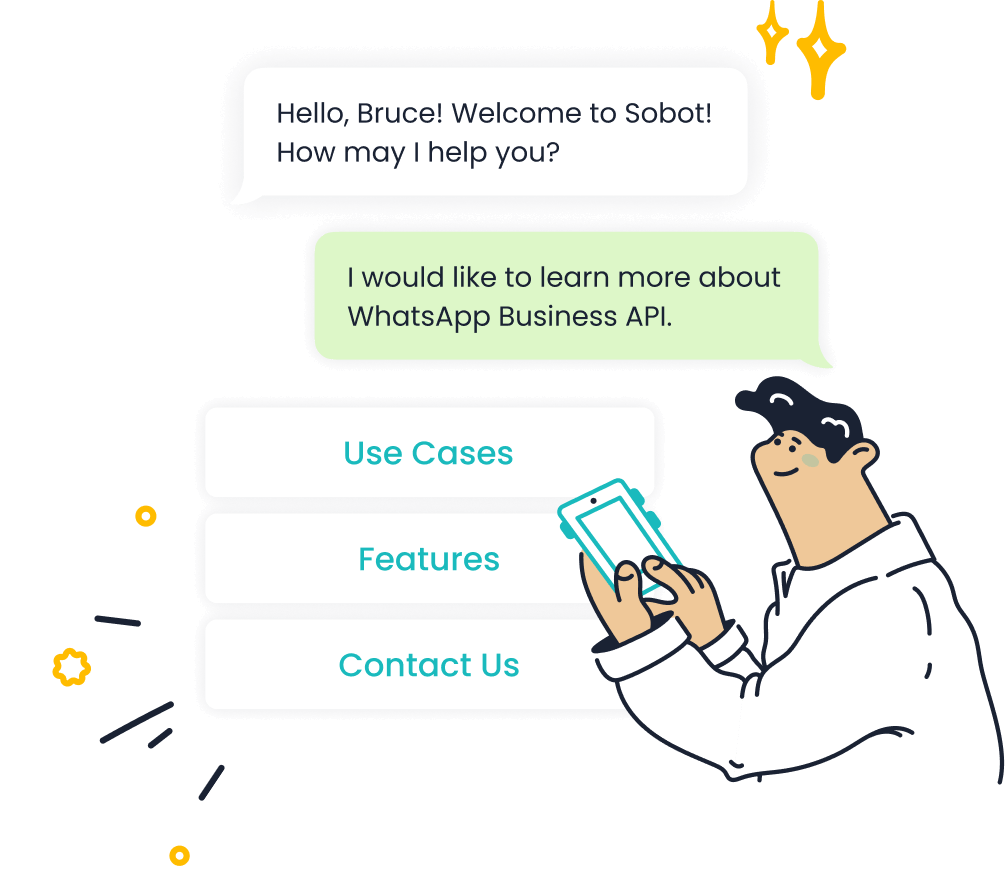What’s Next for Best Omnichannel Software in 2025

Over 90% of businesses will adopt the best omnichannel software strategies by 2025, as mobile commerce grows to nearly 29% of total e-commerce. Companies leveraging Sobot’s AI-driven omnichannel solutions experience up to a 30% improvement in customer satisfaction and a 17% increase in conversion rates. Sobot stands out by helping brands unify e-commerce, customer support, and marketing through advanced Sobot AI and a reliable Sobot call center. These trends drive loyalty and efficiency, as demonstrated by Opay, which achieved a 90% customer satisfaction rate using Sobot AI.
AI Personalization

Customer Experience
AI personalization has transformed how companies deliver customer experiences in 2025. Businesses now use advanced customer data platforms to collect and analyze customer data from every channel. This approach helps brands understand what each customer wants and when they want it. Companies like Nike and Starbucks use machine learning and predictive analytics to offer tailored offers and seamless experiences. For example, Nike increased customer retention by 25% and loyalty engagement by 30% by using a predictive personalization engine.
Sobot’s omnichannel solution uses AI-driven chatbots and real-time data sharing to provide 24/7 personalized support. This ensures that every customer receives quick, relevant responses, which boosts satisfaction and loyalty. AI-powered segmentation allows brands to send targeted messages, reducing irrelevant ads and improving engagement. Studies show that 80% of consumers are more likely to buy from brands offering personalized experiences, and 73% expect consistency across all channels. Companies using AI personalization see up to a 78% increase in conversion rates and a 159% uplift in engagement.
Note: AI-driven personalization also helps reduce cart abandonment and improves inventory management, ensuring products are available when customers need them.

Unified Profiles
Unified profiles play a key role in delivering a seamless experience. By combining customer data from every touchpoint, brands create a single, up-to-date view of each customer. This single customer view supports better customer experience management and enables real-time personalization. AI-powered customer data platforms help segment audiences, predict needs, and recommend the best communication channels.
Companies like the Utah Jazz and nib Health have seen strong results from unified profiles. The Utah Jazz increased revenue per fan by 34% through personalized cross-channel experiences. Unified profiles also help reduce ad spend by targeting only the right customers and suppressing irrelevant ads. Sobot’s platform integrates demographic, behavioral, and transactional data, allowing businesses to deliver consistent, personalized experiences across all channels. This approach leads to higher conversion rates, increased customer lifetime value, and improved retention.
Unified Commerce
Unified commerce stands as the backbone of modern omnichannel commerce in 2025. Retailers and brands now rely on a single technology stack that unites all backend systems. This centralized platform brings together online sales, order management, and real-time customer data, making every transaction visible and traceable. Companies that embrace unified commerce gain a 360-degree view of their customers, which leads to better service and higher loyalty.
Real-Time Integration
Real-time integration connects sales channels, inventory systems, and customer data instantly. Technologies like IoT sensors and cloud-based platforms provide up-to-the-minute inventory visibility. Businesses can adapt quickly to changes in demand, especially during busy seasons. Automated order processing and streamlined distribution reduce manual work and errors. For example, integrating ERP and CRM systems ensures that sales teams always see accurate stock levels, which helps them make reliable promises to customers. This level of integration also frees up IT resources, allowing teams to focus on strategic projects. Sobot’s omnichannel commerce solution offers seamless integration with popular platforms, helping brands automate workflows and deliver faster, more accurate service.
Real-time syncing prevents overselling and stockouts, while centralized order management speeds up fulfillment and improves customer satisfaction.
Consistent Data
Consistent data across all commerce channels is essential for customer satisfaction. Companies that deliver a uniform experience see a 23% increase in revenue. About 75% of customers expect the same experience no matter where they shop. Accurate and updated CRM and product data reduce frustration and help resolve issues faster. Real-time synchronization and centralized data management build trust and loyalty. Consistent product information also decreases returns and boosts customer confidence. Sobot’s omnichannel platform ensures that data stays consistent across every channel, supporting brands as they meet rising consumer expectations in omnichannel commerce.
Note: Centralized data not only improves operational accuracy but also enhances product discoverability and supports better decision-making for future growth.
Omnichannel Shopping Trends

Mobile and Social
Omnichannel shopping trends in 2025 show a strong shift toward mobile-first and social-driven retail. Consumers, especially Gen Z, use platforms like Instagram, TikTok, and Facebook to discover, research, and buy products. Social commerce is growing three times faster than traditional e-commerce, with projections reaching $1.2 trillion by 2025 (source). About 80% of social media use happens on mobile devices, making mobile engagement essential for brands. Retailers now create seamless omnichannel experiences by blending online shopping with in-store perks, such as QR codes and mobile apps that offer rewards for physical visits.

Sobot’s WhatsApp API plays a vital role in this landscape. It unifies communication channels, supports bulk messaging, and enables businesses to reach customers directly on their preferred mobile platform. Brands use Sobot’s API to automate marketing campaigns, send order updates, and provide instant support. This approach increases engagement and drives higher conversion rates. Opay, a leading financial service platform, leverages Sobot’s omnichannel marketing tools and WhatsApp integration to connect with millions of users. Opay achieved a 90% customer satisfaction rate and a 17% increase in conversions by streamlining customer support and marketing across channels.
Retail trends also show that consumers value convenience and personalization. They often research products online but complete purchases in-store, blending digital discovery with physical retail. Retailers who deliver consistent omnichannel commerce experiences see higher loyalty and sales.
Immersive Experiences
Retailers now invest in immersive experiences to enhance omnichannel commerce. Technologies like AI-powered apps, virtual mirrors, and in-store digital tools create personalized shopping experiences that bridge online and offline retail. Customers can compare products, access information instantly, and receive tailored recommendations. These innovations make the shopping experience more engaging and unified across all touchpoints.
Phygital strategies, such as Buy Online, Pick Up In-Store (BOPIS), allow consumers to move smoothly between digital and physical channels. Retailers use omnichannel marketing to deliver targeted offers and content, increasing customer engagement. Research shows that immersive environments, supported by both technology and human interaction, foster trust and loyalty. Senior retail managers report that these experiences positively influence customer engagement at every stage, from pre-purchase to post-purchase.
Omnichannel commerce now relies on integrating retail media networks, social commerce, and advanced personalization. Brands that adopt these e-commerce trends can respond quickly to changing consumer behaviors and deliver consistent, high-quality omnichannel experiences. Sobot’s solutions help retailers manage these complex interactions, ensuring that every customer receives a seamless and satisfying shopping experience.
Advanced Inventory
Real-Time Visibility
Retailers in 2025 rely on real-time inventory visibility to deliver accurate, fast, and reliable omnichannel fulfillment. By integrating Enterprise Resource Planning (ERP) systems, businesses gain up-to-the-minute data on stock levels and locations. This integration forms the backbone of modern retail operations, supporting seamless order processing and reducing costly errors. Real-time visibility allows companies to optimize inventory, avoid stockouts, and minimize overstocks. Customers benefit from accurate order information, timely deliveries, and real-time tracking, which elevates the shopping experience and builds loyalty.
Real-time inventory control also enables retailers to fulfill orders from the nearest warehouse, reducing shipping costs and delivery times. This approach supports efficient last-mile delivery and continuous customer updates, which are essential for a positive shopping experience.
A unified dashboard consolidates inventory data across all channels, improving first-time fill rates and reducing split shipments. Retailers can order the right products in the right quantities, optimizing inventory location based on proximity to customers. This leads to increased profitability and smoother workflows. Sobot’s omnichannel solution provides centralized inventory management, helping brands maintain accurate stock levels and deliver consistent omnichannel fulfillment.
Automation
Automation transforms inventory management in retail by streamlining repetitive tasks and improving accuracy. Automated Guided Vehicles (AGVs) and Automated Mobile Robots (AMRs) speed up order fulfillment by handling product movement within warehouses. Artificial Intelligence (AI) and Machine Learning (ML) analyze complex data sets for quality control and demand forecasting, which enhances inventory accuracy and reduces errors.
- Automation improves inventory accuracy and saves time by digitizing data collection.
- AI-powered robots and IoT sensors enable real-time, item-level inventory visibility.
- AI reduces inventory carrying costs by about 20% and stockouts by up to 50% (McKinsey).
- Order fulfillment accuracy can increase by around 25% through automation.
| Business Size | Revenue Increase (%) | Order Accuracy Improvement (%) | Time Saved on Inventory Tasks (hours/week) | Customer Satisfaction Impact (%) |
|---|---|---|---|---|
| Small | 15 | 20 | 10 | 10 |
| Medium | 25 | 30 | 25 | 15 |
| Large | 35 | 40 | 50+ | 20 |

Sobot’s platform leverages AI and automation to support advanced fulfillment options like BOPIS and ship-from-store. Automated inventory syncing and real-time tracking ensure that retailers can meet customer expectations for fast, accurate omnichannel fulfillment. This technology frees staff for higher-value work and supports smarter demand forecasting, making retail operations more efficient and responsive.
Privacy and Data
Compliance
Omnichannel software in 2025 faces strict privacy and data protection requirements. Businesses must follow global regulations like GDPR and CCPA, which set high standards for data handling and transparency. These laws require companies to collect and process personal data only for specific, legitimate purposes. Customers now have stronger rights, such as the ability to opt out, delete, or correct their personal information. Cross-border data transfers face tighter restrictions, making compliance even more complex.
Key compliance practices for omnichannel software include:
- Informing customers about how their data is collected and used.
- Obtaining explicit consent before processing personal data.
- Providing easy access for customers to view, correct, or delete their data.
- Appointing Data Protection Officers (DPOs) for high-risk activities.
- Using encryption and secure storage for all customer records.
- Conducting regular audits and vulnerability assessments.
- Implementing privacy by design in all systems and workflows.
Sobot’s omnichannel solution supports these requirements by offering centralized data management, encrypted communication, and automated compliance reporting. The platform helps businesses keep records consistent across all channels, making it easier to meet retention and transparency standards. Companies using Sobot can adapt quickly to new regulations and protect customer data at every touchpoint.
Note: Over 90% of consumers in North America and Europe believe brands mishandle customer data, so compliance is not just a legal issue but a trust factor (source).
Trust Building
Building trust in omnichannel software starts with transparency and strong data protection. Customers expect brands to handle their information with care and give them control over their privacy. Leading platforms use unified customer profiles to deliver consistent, personalized experiences across all channels. This approach reduces confusion and builds confidence.
Effective trust-building strategies include:
- Using encrypted platforms to prevent data breaches.
- Providing privacy management options for customers.
- Maintaining consistent brand messaging and communication.
- Training staff to deliver reliable service at every touchpoint.
- Leveraging AI and automation for real-time monitoring and quick response to issues.
Sobot’s omnichannel software integrates these best practices by unifying customer data, supporting encrypted communication, and enabling seamless transitions between channels. The platform’s AI-powered chatbots and live chat features offer real-time support, making customers feel valued and secure. By prioritizing ethical data practices and transparency, Sobot helps brands foster long-term loyalty and trust in a digital-first world.
Tip: Consistent, personalized service across all channels not only improves customer satisfaction but also strengthens brand reputation in the competitive omnichannel software market.
Best Omnichannel Software Features
AI Automation
AI automation stands at the core of the best omnichannel software in 2025. Modern platforms automate inbound and outbound calls, reducing human agent involvement by up to 90%. This shift cuts errors by half and lowers operational costs by 60%. AI-powered chatbots and virtual assistants provide 24/7 support, handling thousands of interactions at once. Customers receive instant, accurate responses, which boosts satisfaction scores by 27%. Automation also enables seamless omnichannel marketing, allowing brands to deliver consistent messaging across voice, chat, email, and social media. By automating routine inquiries, agents can focus on complex issues, improving both efficiency and customer experience. Sobot’s AI-driven contact center and chatbot features help businesses scale support, reduce wait times, and personalize every interaction. Companies like OPPO and Samsung have seen up to 97% customer satisfaction and a 57% increase in repurchase rates using Sobot’s AI automation.
AI automation not only streamlines workflows but also empowers ecommerce brands to optimize operations and drive growth.
Unified Workspace
A unified workspace brings all communication channels—phone, email, live chat, WhatsApp, and social media—into a single dashboard. Agents access customer profiles, order history, and previous interactions without switching systems. This setup reduces response times and improves accuracy. Omnichannel marketing teams benefit from synchronized interactions and real-time updates, ensuring every customer receives a consistent experience. Sobot’s unified workspace integrates seamlessly with CRM and ecommerce platforms, supporting both customer service and sales. Automation tools like smart routing and AI chatbots free agents to handle more complex tasks. Real-time analytics and reporting help managers track performance and optimize strategies. Companies using unified workspaces report faster resolutions, higher agent productivity, and improved customer loyalty.
| Feature | Description |
|---|---|
| Seamless Channel Integration | Unified messaging and experience across all touchpoints |
| Personalization Capabilities | Dynamic content and audience segmentation for targeted omnichannel marketing |
| Analytics and Reporting | Real-time insights and customizable dashboards |
| System Integration | Compatibility with CRM and ecommerce systems |
| Robust Automation Tools | Streamlined workflows and marketing automation |
| Unified Agent Desktop | Single interface for all customer interactions |
| Real-Time Channel Switching | Seamless transitions during customer conversations |
Sobot’s all-in-one solution, including WhatsApp integration, enables ecommerce brands to manage omnichannel marketing, support, and sales from one platform. This approach increases efficiency, reduces costs, and delivers a superior customer experience.
Omnichannel Trends 2025
Generative AI
Generative AI stands at the center of new omnichannel trends in 2025. Companies use this technology to create personalized, proactive, and context-aware communication across calls, chats, emails, and social media. Natural language processing helps brands understand customer intent and sentiment. This allows generative AI to predict issues before they grow and provide real-time, dynamic responses. For example, Airbnb uses generative AI to assist guests with personalized answers, improving the customer experience.
Many businesses now rely on generative AI to power virtual assistants. These assistants handle complex, multi-turn conversations and reduce wait times. They free human agents to focus on more difficult tasks. Generative AI also acts as an intelligent copilot for agents. It suggests responses, summarizes interactions, and recommends next steps in real time. This boosts agent productivity and ensures consistent support across all channels.
Sobot’s omnichannel solutions use AI to deliver unified support and streamline communication. The platform automates call summarization and documentation, which reduces after-call work. Quality assurance improves as AI evaluates every interaction and provides coaching insights. These omnichannel trends help companies build trust and loyalty by offering fast, accurate, and personalized service.
Tip: Generative AI can analyze data and interaction history to anticipate customer needs and deliver tailored solutions at scale.
Edge Channels
Edge channels represent another important shift in omnichannel trends for 2025. These channels include emerging platforms like voice assistants, IoT devices, and in-app messaging. Customers expect brands to meet them wherever they are, whether on smart speakers, wearables, or gaming consoles. Businesses that adopt edge channels can reach new audiences and provide seamless experiences.
Sobot’s platform supports integration with a wide range of edge channels. This flexibility allows brands to unify communication and deliver consistent service, no matter the device or platform. Companies use edge channels to send real-time alerts, offer instant support, and gather feedback. These trends help businesses stay ahead by adapting quickly to changing customer behaviors.
A recent study shows that 65% of consumers interact with brands on at least three different channels before making a purchase (source). By embracing edge channels, companies can ensure they remain visible and responsive across the entire customer journey. Omnichannel trends in 2025 will continue to evolve as technology advances and customer expectations rise.
Retail and consumer trends in 2025 highlight AI integration, unified data, and cross-channel consistency as essential for customer satisfaction. Companies adopting a strong omnichannel strategy, like Sobot, see higher retention and loyalty. To implement new solutions, businesses should:
- Prioritize integration with existing systems.
- Ensure scalability for growth.
- Evaluate technology partners’ expertise.
Opay’s results show that Sobot’s platform can boost customer satisfaction and drive retail success.
FAQ
What is the best omnichannel software for 2025?
The best omnichannel software in 2025 offers unified customer profiles, AI automation, and seamless integration across channels. Sobot stands out with its all-in-one contact center, WhatsApp API, and AI-powered chatbots, helping brands improve customer satisfaction by up to 30%. Learn more.
How does omnichannel commerce improve customer experience?
Omnichannel commerce connects every sales and support channel. Customers receive consistent service, whether they shop online or in-store. Sobot’s unified workspace ensures agents access real-time data, which leads to faster resolutions and higher satisfaction rates.
Why is AI automation important in omnichannel marketing?
AI automation streamlines repetitive tasks and personalizes communication. Sobot’s AI-driven chatbots handle thousands of inquiries at once, reducing wait times and boosting engagement. Businesses using AI automation in omnichannel marketing see up to a 27% increase in customer satisfaction.
How does Sobot ensure data privacy and compliance?
Sobot’s omnichannel software uses encrypted communication, centralized data management, and automated compliance reporting. These features help businesses meet global privacy standards like GDPR and CCPA, building trust with customers and protecting sensitive information.
Can Sobot’s WhatsApp API support large-scale omnichannel marketing?
Yes. Sobot’s WhatsApp API enables bulk messaging, 24/7 chatbot support, and smart chat routing. Brands use it for omnichannel marketing campaigns, order updates, and customer support. Opay achieved an 85% message reading rate using Sobot’s WhatsApp integration.
See Also
Comprehensive Overview Of Omnichannel Call Center Platforms
Step-By-Step Process For Deploying Omnichannel Contact Centers
Revealing The Best Cloud-Based Contact Centers For 2025
